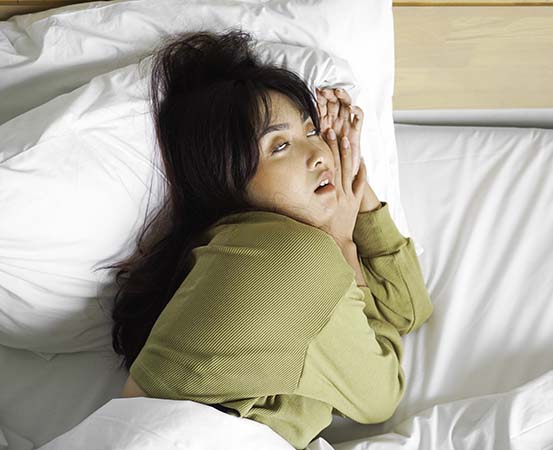
A 55-year-old woman from Hyderabad was struggling with hypertension and had been hospitalized several times due to cardiac issues. She was also overweight and had sleep-related issues, such as excessive daytime sleepiness, not feeling refreshed after waking up, poor performance at work and irritable moods. Despite visiting many doctors, she could not find a solution for her sleep issues. Additionally, her partner shared that she snored while sleeping. She would also doze off while watching TV or even sitting. Eventually, she was referred to a sleep specialist, who recommended a sleep study and diagnosed her with severe obstructive sleep apnea (OSA). After that, she was placed on CPAP machines and her snoring and breathing got better, and now she is sleeping well.
OSA, which has symptoms like snoring, daytime sleepiness, and cardiovascular issues, has commonly been seen as a condition in males. However, experts say that sleep apnea in women may often go underdiagnosed. In a study published in European Respiratory Journal, a polysomnography test was conducted on over 400 females aged 20 to 70 years, where it was seen that 50% of the females had sleep apnea. Of this, 84% was seen in women with obesity and about 80% of the test subjects had hypertension.
What causes sleep apnea in women?
Health professionals say irrespective of gender, OSA is more common among individuals with obesity. However, common symptoms like snoring, excessive daytime sleepiness and lethargy may not necessarily be seen in women as typical manifestations. “Sleep apnea in women may manifest as insomnia, accompanied with other symptoms like irritable mood, lack of sexual interest, poor work performance, headaches in the morning and even nocturia,” shares Dr Viswesvaran Balasubramanian, consultant interventional pulmonology and sleep medicine, Yashoda Hospitals, Hyderabad.
While discussing the effects of sleep apnea in people, Dr Suhas HS, consultant pulmonologist, Manipal Hospitals, Bangalore, reveals, “In individuals with sleep apnea, the muscles in the back of the throat relax during sleep, reducing the space for air to pass through. This causes reduced oxygen supply, leading to snoring. It can result in sleep disruptions.” He shares that even the brain stem fails to communicate with muscles responsible for breathing, resulting in shallow and abnormal breathing patterns.
Dr Balasubramanian shares that many women may experience sleep problems during perimenopause as hormonal levels and the menstrual period become irregular. “In menstruating women, appropriate levels of hormones like estrogen and progesterone help maintain the muscle tone of the airway and prevent it from collapsing. However, several changes in post-menopausal state like weight gain, higher BMI, larger neck circumference, and higher waist-hip ratio may predispose postmenopausal women to a higher risk of OSA,” he informs. Risk factors for sleep apnea in women include:
Age: Advancing age increases the risk of sleep apnea.
Head and neck anatomy: Obstructive sleep apnea occurs more frequently in people who have specific anatomical features including a larger tongue and a shorter lower jaw.
Body weight: Obesity adds to the risk of developing sleep apnea.
Other risk factors: Cigarette smoking, alcohol consumption and a family history of sleep apnea can lead to an increased risk of developing the condition.
Why is sleep apnea in women underdiagnosed?
According to a study published in Yale Journal of Biology and Medicine, while OSA does tend to affect men more than women, its prevalence is high in both genders and increases with age. It also says that OSA is underdiagnosed, but more so in women than men.
Certain factors such as the anatomy of the upper respiratory tract in women favour lesser incidents of sleep apnea in women as compared to men, explains Dr Suhas. “However, unlike in men, women may present with anxiety, depression, insomnia, hallucinations, restless legs syndrome and palpitations, which lead to the condition being underdiagnosed,” he says. Experts also say that untreated sleep apnea in women results in high blood pressure, uncontrolled diabetes mellitus and increased risk of cardiovascular issues such as heart attacks and strokes. The condition may also cause or aggravate anxiety and depression.
Ways to manage sleep apnea in women
While moderate to severe apnea requires positive airway pressure therapy, mild obstructive sleep apnea can be managed with some lifestyle modifications. These include:
• Manage body weight
Obesity is a risk factor for sleep apnea. Excess weight can lead to the accumulation of fat in the neck, which can obstruct the airway and impede breathing. Therefore, weight loss can be beneficial in decreasing the likelihood of developing OSA.
• Exercise regularly
Working out regularly can help you lose weight.
• Alter sleeping positions
Sleeping on your back blocks the airway as the tongue falls back, which can cause snoring. Hence, experts advise sleeping on the sides so airways remain open, reducing snoring and making breathing easier.
• Reduce alcohol intake
Consumption of alcohol can obstruct one’s upper airway, affecting the breathing of an individual and leading to an increased risk of sleep apnea.
• Follow good sleeping habits
Napping during the afternoon can disrupt sleep at night. You can avoid taking naps during the day for quality sleep at night.
Takeaways
- Obstructive sleep apnea (OSA) has commonly been seen in males. However, experts say it often goes undiagnosed in women.
- Sleep apnea in women may manifest as insomnia, accompanied by symptoms like irritable mood, lack of sexual interest, poor work performance and early morning headaches.
- While moderate to severe apnea requires positive airway pressure therapy, mild obstructive sleep apnea can be treated with lifestyle modifications like reducing body weight, following sleeping habits and exercising regularly.

















